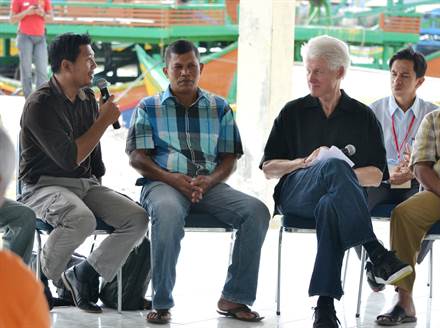
Former President Bill Clinton visits Aceh, Indonesia to view tsunami recovery
-
Coastal resilience
-
Coastal wetland conservation
-
Integrated delta management
Ten years after the major tsunami hit Aceh, Indonesia in 2004, President Clinton visited the village of Layeun to find out what more can be done to support their recovery. While some areas are recovering, other communities are still on the edge of poverty. During the visit Wetlands International announced a new commitment to support and empower the villagers by restoring the local environment and working with the community to diversify their livelihoods for sustainable income generation. This initiative will build on our Green Coast project that restored coastal ecosystems after the tsunami.

Ten years after the major tsunami some local communities still struggle. The tsunami swept away everything along 800 kilometres of the coast of Nangroe Aceh Darussalam, causing the death and loss of 167,000 people, while more than 500,000 others lost their homes and livelihoods. Mangroves and other coastal forests were uprooted, reefs damaged and the entire coastline re-shaped by the uplift and powerful waves. Layeun village was the hardest hit of all and the damage to fishing boats, trading facilities, and aquaculture ponds paralyzed their livelihoods. President Clinton visited the village to find out what more can be done to support their recovery.
During the visit of the President to the village of Layeun, Wetlands International introduced him to community representatives from neighbouring villages, who received support from the Green Coast Project. They shared their experiences and highlighted what more is needed to secure their futures.
Pak Nyoman Suriyadiputra, Director of Wetlands International Indonesia said, “Thanks to Green Coast we can now see thick mangrove forests between the Banda Aceh community settlement areas and the sea where there was just bare land after the tsunami. These mangroves will help protect the people and provide a nursery for the fish stocks. But full recovery of the fishery takes more time. With technical guidance and sharing of experience, we can further enable local communities to take action that will improve their local environment and help them to bounce back stronger.”
Part of the problem is that a healthy coastal ecosystem is needed as this has vital roles for fisheries, aquaculture and other sources of income. Naturally, most of the aid that followed the tsunami focused on immediate humanitarian assistance of food, water and shelter plus building back houses and other infrastructure.
Wetlands International commitment
In order to support local community in their effort to achieve healthy coastal ecosystems, Wetlands International is supporting a programme to address the key problems faced by the community. We will bring in experienced local facilitators from the Green Coast project and technical specialists who can help local community groups develop and implement their own programme of action. The work will start with a full assessment of the problems villagers face and the root causes of those problems. Awareness raising, technical guidance and training will be held in this village to improve community’s awareness and skills, so that they will be capable to implement the programme by themselves. Wetlands International will draw on successful experiences in the Green Coast project, for example in linking community efforts for ecosystem restoration with incentives for livelihood improvement.
Green Coast investments in sustainable recovery
The Green Coast project led by Wetlands International and supported by Oxfam Netherlands, invested in enabling the remaining local communities to restore the basis of their future livelihoods, for example by replanting mangroves to protect and secure their small scale fish ponds and to provide a future buffer against storms.

Contact:
Pak Yoyok (Iwan Tri Cahyo) Wibisono, Senior Forestry Specialist : [email protected]
Pak Nyoman Suryadiputra, Director : [email protected]
Jane Madgwick, CEO; [email protected];
More Information:
- Green Coast Project (2005-2008):
Soon after the December 2004 tsunami, NGOs worldwide appealed for support in their efforts to recover damaged coastal ecosystems and to reform coastal policies. Following urgent pleas from their local partners, four international organisations developed the Green Coast Project: Wetlands International, IUCN NL, WWF and Both ENDS. The project was coordinated by Wetlands International.
Green Coast aimed to restore livelihoods of local communities through the recovery of coastal ecosystems, which play an important role in providing safety and sources of income.
Although an emergency response project, Green Coast was developed with a long term perspective; recovery of coastal livelihoods through the restoration and sustainable management of coastal nature takes decades. In Indonesia, Sri Lanka, India, Thailand and Malaysia partner organisations worked together in three closely interlinked components, to:
- Assess tsunami impacts on ecosystems and livelihoods, as well as local communities views and rights;
- Influence governments, aid agencies and the corporate sector to sustainably manage and restore coastal natural resources;
- Facilitate small grants for community-based restoration projects.
The Green Coast project helped 91.000 people along the coast of Aceh and Nias Island from 2005-2008. Wetlands International helped local community groups by providing capital, training them how to establish tree nurseries and to restore and maintain coastal ecosystems. In return for their efforts, these communities gained financial support to establish small businesses, such home industry, duck farming, cow farming, fish farming, and mangrove seedling business.
Lessons Learnt from the post-tsunami Green Coast project in Aceh (2005 – 2009); community-based coastal ecosystem & livelihoods restoration.
Best Practice Guidelines on Restoration of Mangroves in Tsunami Affected Areas
Demonstration of Community-based Mangrove Reforestation in Aquaculture Landscapes to Promote Ecological Productivity, Sustainability, and Environmental Security in Aceh
Media coverage of our coastal restoration work in Aceh after the tsunami (2005 – 2008): Green Coast in the press
2.Wetlands International and Coastal Resilience in Indonesia
Summary of Mangrove Capital Programme in Indonesia: Mangrove Capital
